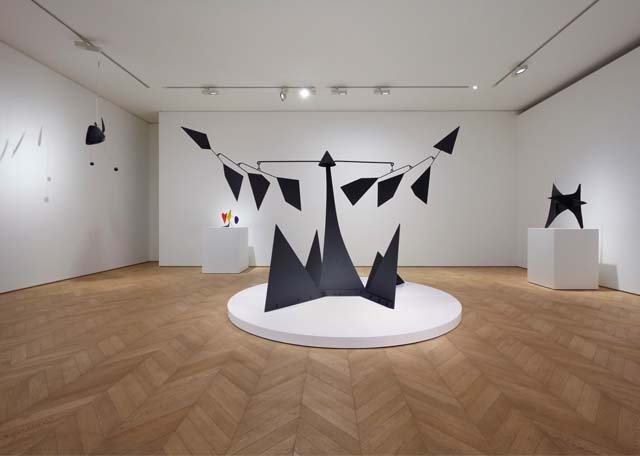本文是一篇一篇优秀的essay代写范文,题目为The understanding of sculpture art,范文主要讨论了对雕塑艺术的理解。文章讲述1942年亚历山大·卡尔德(Alexander Calder)创作的“移动”作品典型地展示了他自己的风格和对雕塑艺术的理解-移动物体以及使用金属线,碎片和各种颜色来代表雕塑的移动性和灵活性他的工作。野口勇(Isamu Noguchi)的作品“ Kouros”是极端抽象雕塑的插图,它被命名为“ Kourus”,但实际上是一件互锁的作品,它用细针相连的石头代表了“少年”的非常模糊的图像。 ”(“ Kouros”)。这两件作品都可以被描述为“抽象”雕塑,但其内在的含义却有很大不同,这与两位艺术家的背景,环境,艺术研究等息息相关。
The understanding of sculpture art
The work “Mobile” by Alexander Calder which is made in 1942, is a typical demonstration of his own style and understandings of the sculpture art—the moving objects and the use of metal lines, pieces and various colors to represent the mobility and flexibility of his work. Whereas the work “Kouros” by Isamu Noguchi is the illustration of extreme abstract sculpture—it is named “Kourus”, but it is actually an interlocking piece of work, using stones connected with very thin needles to represent a very blurred image of “teens” (“Kouros”). The two works can both be described as “abstract” sculptures, but it has very different meaning deep inside, which is closely linked to the background, environment, study of art, etc. of the two artists. Generally, the messages that Calder tried to convey were energetic, vibrant ones; and for Noguchi, it is the deep worry and a sense of fragments. We shall discuss these differences along with their work in the next paragraphs and to see what led them to the different way.
亚历山大考尔德于1942年创作的“流动”作品,是他对雕塑艺术的风格和理解的典型展示——移动的物体以及用金属线条、碎片和各种颜色来表现其作品的流动性和灵活性。野口由人的作品“Kouros”是极端抽象雕塑的插图,它被命名为“Kourus”,但它实际上是一个相互联系的作品,用石头和非常细的针连接起来,来表现一个非常模糊的“青少年”(“Kouros”)形象。这两件作品都可以用“抽象”雕塑来形容,但其深层含义却截然不同,这与两位艺术家的背景、环境、艺术研究等密切相关。一般来说,考尔德试图传达的信息是充满活力的,充满活力的;对野口佳彦来说,这是一种深深的忧虑和碎片感。我们将在下一段讨论这些差异以及他们的工作,看看是什么导致他们走上不同的道路。
Alexander Calder, as a man born in the family of sculptors, and a man heavily influenced by French sculptor Miro and Dadaism art during the 1920s and 1930s, elaborated his own style of sculpture in 1942 and made this sculpture of “Mobile”. The current Joan Miro retrospective, at the Museum of Modern Art, could provide new critical standards to consider the implications of populism in the American's work as much as in that of his Spanish colleague and inspiration, whose work is securely within the pantheon of modernism, and Calder’s sculpture can be analyzed through this trend. Different from any other forms of sculptures before his age, he put more emphasis on the mobility and flexibility of the sculpture, making them moving objects instead of merely standing ones. In “Mobile”, Calder used thin pieces of aluminum, steel and wires to piece the whole work together. The whole sculpture looks like a big clothes stand, with many different parts hanging out from the body. And indeed, the sculpture itself was being hung in the exhibition, so that it moved from time to time and changed its relative position consecutively. This was by no means “traditional” sculpture; it was a total innovation in sculpture, and soon made Calder very famous as one of the founders of the mobile sculpture.
亚历山大·考尔德出生于雕塑家之家,在20世纪二三十年代深受法国雕塑家米罗和达达主义艺术的影响,他在1942年阐述了自己的雕塑风格,并将这座雕塑打造成了“流动的”。目前,在现代艺术博物馆举办的琼·米罗回顾展,可以提供新的批评标准来考虑美国作品中的民粹主义影响,就像他的西班牙同事和灵感一样,后者的作品完全属于现代主义的万神殿,考尔德的雕塑可以通过这一趋势进行分析。不同于他之前的其他雕塑形式,他更强调雕塑的流动性和灵活性,使之成为移动的物体,而不仅仅是站立的物体。在“Mobile”中,考尔德用铝、钢和金属丝将整个作品拼接在一起。整个雕塑看起来像一个大衣架,有许多不同的部分悬挂在身体上。事实上,雕塑本身就被悬挂在展览中,因此它不时地移动,并不断地改变其相对位置。这绝不是“传统”雕塑;它是雕塑的一次彻底革新,很快使考尔德成为著名的流动雕塑创始人之一。
The work “Mobile” was not a complicated sculpture with delicate design and outstanding handicraft work; it is rather simple, as a matter of fact, and the structure is quite clear. However, the difficulties that lie in analyzing this work of art result from the simplicity—since people in general do not understand the essence of its design, they cannot get the message that the artist is trying to convey. Furthermore, the sculpture is a mobile one, just as its name; unlike traditional ones, it is hung from upside to downside, and it spins naturally as the structure went. All these designs can be seen as the reflection of French Dadaism that had influenced Calder deeply—his work was closely linked to the abstractionist school, which does not take the shape and physical appearance, but inner spirits and signified characteristics highly. The “Mobile” is a very unique representative of the abstractionist school: first, it has no concrete shape to describe a man, an object, or something we can tell; it is merely a combination of different metal pieces and strings; second, it does not have the common emoting elements as the traditional sculptures, which are presented through the features or certain manners of the work; rather, the simple structure aims to tell us what “Mobile” really means, by making all these strings and metal pieces move naturally through direct hanging them. It is a symbol of mobile and mobility.
The work was highly praise and awarded during the 1942 exhibition "Artists for Victory" at the Metropolitan Museum of Art. The Sculpture Committee recommended it to be added to the collect, which showed how influential Calder’s work is, even at that time. Although in the future career life of Calder, he did design a number of public sculptures which are put outdoors, but the core of his abstract sculpture had been kept ever since, so one should say that “mobile” is a typical piece of work of Alexander Calder. In fact, most often Calder has been concerned with how his work moves. Even the stabiles are concerned with movement-the movement of the spectator around and through the object.
For the Japanese American Isamu Noguchi, the sculpture is a different story. Born in a family of Japanese father and American mother, Noguchi’s life experienced a series of twists and turns—his father and mother divorced when he was only 14, and he went back to US to finish his high school studies. He first started his university life as a medical student, but due to the enthusiasm in sculpture in later years, he picked up sculpture and learned from various surrealist artists, which included Miro, the one that also influenced Calder. During 1945 and 1948, he sculpted 15 interlocking sculptures, and the “Kouros” was among those works. Noguchi used heavy pink marbles as the medium and cut them into two large pieces, which were also abstract shapes that people could not understand at their first glance. The way that Noguchi interlocked those pieces were very curious—he used very thin pieces of marble, as thin as needles, to penetrate each pieces and linked them together in different positions, so that the whole work looks like fragments lying and hanging together, with thing needles holding them. The sculpture itself is about 9 feet tall, and the shape looks weird and curious for the viewers.
Noguchi had studied from many artists during the 1930s, including eastern master Qi Baishi (Ch’i Pai-shih) and western artists. Noguchi's training under Ch'i Pai-shih in Peking may have left as deep an impression on the young artist as Constantin Brancusi had in Paris, since both Brancusi and Ch'i were charismatic artist. His work demonstrated a very obvious style of surrealism and abstractionist, which is much alike to those of Calder; but also, we can see strong presence of traditional Japanese art style in “Kouros”, it looks like a combination of traditional Japanese work of art and western abstractionist art, as it could be seen from the shape of the marbles. Unlike Calder’s “Mobile”, which aims to use light objects to present the status of “mobile”, Noguchi’s “Kouros” is a large, steady sculpture which stands on the ground. The feeling of fragmentation is strongly presented through the design, leaving people an impression of split and confusion. At that time, the world suffered from WWII and just regained peace. “Kouros”, meaning “young people” in the world, were lost to the post war trend and the world. The “Kouros” has a very strong sense of confusion and loss of future, indicating Noguchi’s worries about the future. Noguchi’s own identity of Japanese American had probably given him inspirations of the work: he was imprisoned by the American government in 1941 for his Japanese blood lineage, and was released only after many of his artist friends came up to rescue. The hostility status of the Americans towards Japanese and Japanese Americans made Noguchi depressed, for a moment he could not see the future, and the young people who experienced the war and similar feelings. Out of this, Noguchi designed “Korous” to show his worries of the precarious post war world. The sculpture looks lonely and separated, being linked with only thin pieces of marbles. The shape looks like human organs, maybe legs, which symbol uncertainty and separation. Noguchi’s later works were mostly about industrial design and large public sculptures, which had few similarities with earlier works such as “Kouros”. It can be told that the style of this sculpture is typical of Noguchi, but the work itself is the product of his particular time, which could not be understood as “typical work”.
In general, Calder and Noguchi both belong to the school of surrealism and abstractionist. Both their works are not restrained by outer shape but inner emotions; expression is more valued in their sculptures than appearances. While for Calder, his experiences in France and the sculpture traditions of his family left him energetic and flexible style of design, which can be felt at the moment we see the work; whereas Noguchi’s “Kouros” is more about depression, steadiness and confusion, he used the abstract works to present his own feelings about the world during the particular time and his own experience. Although both works were from the same time, the artists’ life experiences gave their sculptures totally different feelings.
Works Cited
Denton, M. (1969). Review of Alexander Calder by Joan M. Marter. College Art Association, 105-107.
Maeda, R. J. (1999). Isamu Noguchi and the Peking Drawing of 1930. American Art, 85-93.
Rose, B. (1969). A Salute to Alexander Calder. Members Newsletter, 10-12.









